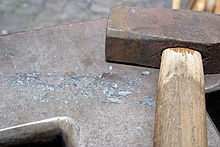Burn-off (metallurgy)
In metallurgy, burn-up is the term used to describe the loss of metal that results from burning , gasifying , spraying , slagging or scaling.
Metal processing
In metal processing, material loss occurs on metal surfaces through oxidation of the metal under the action of oxygen and other oxidizing gases at high temperatures, such as in gas welding . These include, for example, the small iron oxide platelets (Fe 3 O 4 , hammer blows or tinder ) that spring off the workpiece when iron is forged. The term “ tinder” and “ scaling” in metallurgy refers to the similarity between this burning process and the smoldering of ignition material to start a fire ( tinder ). Since the preparation of metal alloys at high temperatures is carried out, there is a loss in the alloying of the individual elements by burning, by chemical reactions cause the formation of slag in the molten bath. The extent of this burn-off must be taken into account when adding the alloying elements in order to obtain the desired chemical composition of the molten metal, which in turn determines the properties of the product (e.g. cast block, casting). See also: scale , scale washer , hematite , magnetite , gating .
For metals that are exposed to high temperatures, the temperature up to which the material is resistant to scaling is often specified . In the case of steels, this temperature is often between 750 ° and 1250 ° C.
Ore processing
- Residue from roasting sulfur-containing ores .
Electrical engineering
- Removal of contact material through spark formation (coarse burn-off) or micro-welding (fine burn-off). This can occur at relay contacts , for example .
Individual evidence
- ^ Alfred Herbert Fritz: Fusion welding process . In: Alfred Herbert Fritz (Ed.): Manufacturing technology . 12th edition. Springer Vieweg, Berlin 2018, ISBN 978-3-662-56534-6 , pp. 527 .
